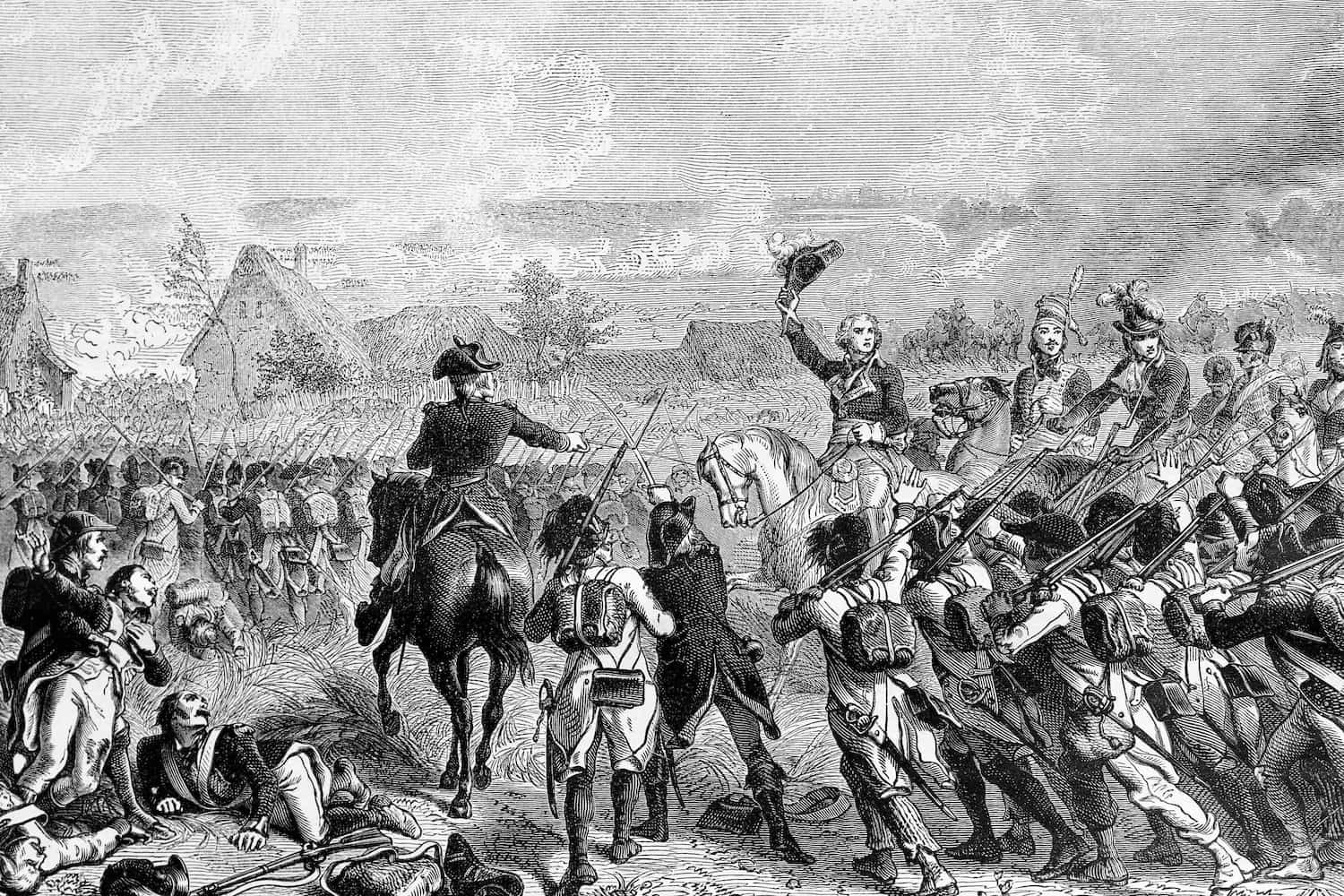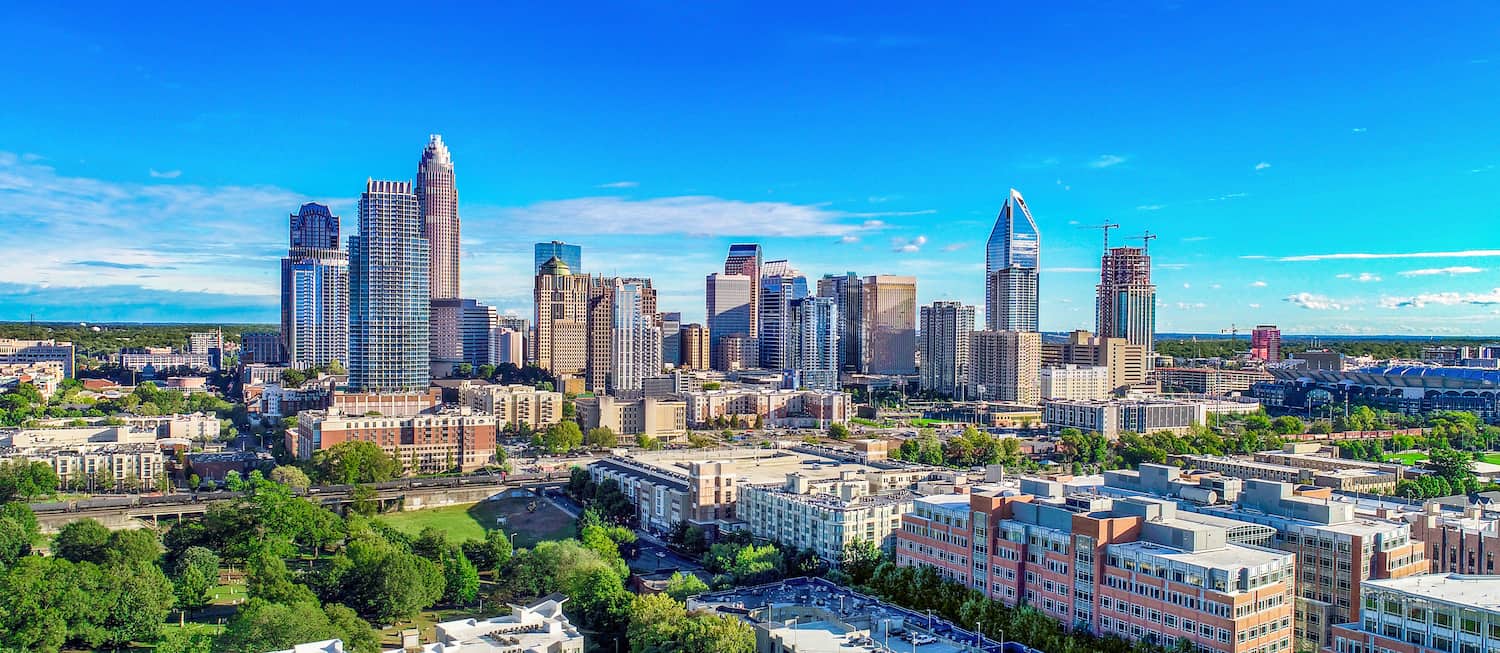Charlotte, NC: The Queen City. 👑
- A city of 870,000+ people that calls its downtown area “Uptown.” 🏙️
- A city with hornet mascots everywhere. 🐝
- The 16th largest city in the U.S. 🇺🇸
There’s no denying that Charlotte, North Carolina, is a bright and bustling modern city that houses thousands of young professionals, families, and businesses. But how did Charlotte grow into the metropolis it is today?
Let’s take a closer look at the Charlotte history that stems all the way back to the 1700s.
1567-1759: The Catawba Native Americans Occupy the Area
Before European colonists entered what is now The United States, indigenous tribes occupied the land. The first known Native American tribe to settle in modern-day Mecklenburg County (the county Charlotte is in) was the Catawba people.
- The Catawba people were also known as “Iswa,” which comes from the Catawba translation of Ye Iswą, meaning “people of the river.”
- This tribe of people lived off the land by hunting and fishing to provide for their families.
- Catawba women were noted as exemplary makers of pottery and baskets.
Early Spanish explorers estimated the Catawba population to be around 15,000 people. Unfortunately, European colonialism led to the Catawba decline.
In 1738, a smallpox epidemic broke out among the tribe. Smallpox was endemic among the settling Europeans, but it was a brand new disease to America at the time— so the Catawba people hadn’t acquired immunity to it.
Smallpox affected the tribe again in 1759, and by 1784, only 250 Catawba people were reported.

1750- 1780: Early Settlement and Incorporation (Oh, and the Revolutionary War)
European settlers moved into the Charlotte area around 1750, roughly. The town was first developed by Scottish-Irish Presbyterians, who made up much of the original founding population.
Charlotte was incorporated in 1768, and it was named after Princess Charlotte Sophia of Mecklenburg-Strelitz— King George III’s queen. Thus, Charlotte was nicknamed the “Queen City,” and the county was named Mecklenburg County.
In 1770, surveyors marked the streets in a grid pattern, which still exists today. The intersection of two streets called Trade and Tryon became known as “Independence Square,” or more simply, “The Square,” which is at the heart of Uptown.
During the American Revolutionary War, which lasted from 1775 to 1783, the town was occupied by Lord Charles Cornwallis. Lord Cornwallis is said to have received very hostile treatment and called the town “the hornet’s nest of rebellion,” which is why the hornet is the city’s official emblem and the mascot of Charlotte’s NBA basketball team.
The town was chartered as “Charlotte,” but the name appeared as “Charlottesburgh” on many maps until about 1800.
The 1800s: Gold, Railroads, and Growing Pains
Since Presbyterians primarily occupied the area at settlement, Charlotte was thought to be the home of Southern Presbyterianism. But Charlotte was quickly adorned with another nickname— “The City of Churches,” because many other churches formed, including:
- Roman Catholic
- Baptist
- Lutheran
- Episcopal
- Methodist

In 1799, a 12-year-old boy named Conrad Reed found a 17-pound rock that his family used as a doorstop. Three years later, in 1802, a jeweler determined that the shiny rock was practically solid gold and paid the family a whopping $3.50 for it.
This was the first documented gold found in North America, which set off the first nationwide gold rush. Many gold veins were found in the area, and North Carolina was even the primary producer of gold in the U.S. until 1848, when larger gold mines were discovered.
In 1852, a new industry overtook the gold industry: the railroad. Local investors in Charlotte and upstate South Carolina completed the first rail line that ran through the Carolinas. Eventually, more railroad crossroads were built, making Charlotte a hot spot during the Civil War from 1861 to 1865.
The Civil War was, of course, a trying time for the entire country. The last full session of the Confederate cabinet was held in Charlotte, and when the Confederacy fell in 1865, southern cities like Charlotte had to grapple with no longer relying on forced slave labor for their industries.
Mecklenburg county was comprised of 40% Black Americans who were now free by the end of the Civil War. The region began to embrace factories and industrialization like many northern states, but segregation remained to be a problematic issue for decades.
The 1900s: Higher Education, Rising Population, and Civil Rights Reform
In the early 1900s (and late 1800s), many colleges and universities opened in Charlotte, leading the way for the city to become a leader in higher education:
- The University of North Carolina, Charlotte (1946)
- Johnson C. Smith University (1867)
- Queens College (Now Queens University of Charlotte) (1857)
- King’s College (1901)
- Central Piedmont Community College (1936)
Charlotte’s population kept growing, and it has always been North Carolina’s largest city, except for the 1920 census, where Winston-Salem surpassed Charlotte’s population by 2,000 people.
Even in the wake of the “New South,” segregation laws remained, allowing for unfair treatment of Black Americans. As the civil rights movement began, Charlotte was an integral place.
In the mid-1950s, African American leaders in Charlotte succeeded in desegregating Revolution Park and the Charlotte Douglas International Airport. In 1960, students at Johnson C. Smith University organized one of the largest sit-ins in the South, which led to lunch counters being open to all people.
In 1983, Harvey Gantt was elected as the first Black mayor of a majority-white U.S. city.

The Post-Civil Rights Era: A City in Transformation
Beyond the Civil Rights Movement, Charlotte underwent significant socio-economic changes that would shape its future. The city expanded its urban development and began major revitalization projects in the 1970s and 1980s, leading to an economic boom.
- Banking Boom: By the 1990s, Charlotte had established itself as the nation’s second-largest banking center, surpassed only by New York City. Institutions like Bank of America and Wachovia (later acquired by Wells Fargo) became dominant figures, drawing young professionals to the city and greatly influencing Charlotte’s skyline.
- Airport Expansion: The Charlotte Douglas International Airport became one of the busiest airports in the country, facilitating commerce and trade. The airport’s growth signified Charlotte’s rising prominence on the national and international stage.
- Diversity and Culture: As the city grew economically, Charlotte became a cultural hub in the South. With the National Whitewater Center, the Bechtler Museum of Modern Art, and the annual Charlotte Jazz Festival, the city attracted artists and cultural enthusiasts.
- Transport and Infrastructure: 2007 saw the inauguration of the Lynx Blue Line light rail, a significant move towards modernizing the city’s transportation and reducing vehicular congestion.
Charlotte and the Green Movement: Towards a Sustainable Future
Charlotte’s growth was not just in terms of economic prowess; the city was also keenly aware of its environmental footprint and actively worked towards sustainable living.
- Sustainable Initiatives: By the 2010s, the city launched several green initiatives. Envision Charlotte, for instance, was a public-private collaborative aiming to reduce energy consumption in Uptown Charlotte by at least 20%.
- Urban Farming and Local Produce: Farmers markets became popular, and urban farming projects began to sprout. Places like the 7th Street Public Market encouraged local produce and artisanal products, promoting healthy and sustainable lifestyles.
- Parks and Green Spaces: With an aim to provide a green space within a ten-minute walk for every resident, the city started enhancing its parks. The Little Sugar Creek Greenway, a reclaimed urban stream, is an example of Charlotte’s commitment to blending urban life with nature.
- Renewable Energy: Charlotte didn’t just stop at sustainable urban projects. It also began investing in renewable energy, with companies like Duke Energy focusing on solar and wind energy projects.
As Charlotte propels into the future, its rich history and forward-thinking initiatives make it an exemplar of balanced urban development.
2000s-Today: A Modern-Day Melting Pot
Charlotte’s population kept growing… and growing… and growing! Today, the population has grown to over 873,000 people, with all of Mecklenburg County at well over 1 million people. Charlotte has become an industry leader in many fields, including:
- Banking
- Education
- Healthcare
- Automotive
- Manufacturing
- Technology
- Art
Charlotte also has many major professional sports teams, including:
- The Charlotte Hornets (Basketball) 🏀
- The Carolina Panthers (Football) 🏈
- Charlotte FC (Soccer) ⚽️
Plus, college basketball is popular in the area thanks to Duke University and The University of North Carolina at Chapel Hill.
The Charlotte area is quite diverse, as the city was the fastest-growing major Latino metropolis in the entire country from 2000 to 2013. This culturally-rich modern city has plenty of art, food, and entertainment for people of all ages and walks of life to enjoy.
We Love Supporting Our Charlotte Community
It’s no secret that Charlotte, NC, is a fantastic place to live, work, and visit. As a local business in Mecklenburg County, our team at Tidds Roofing loves to get involved in our community and carry on Charlotte’s legacy.
If you find yourself newly situated in the Charlotte area, or if you’ve lived here for years, our team would be honored to provide the roofing services you need to keep your home safe and comfortable. Reach out today if you need a home service partner in Charlotte!



